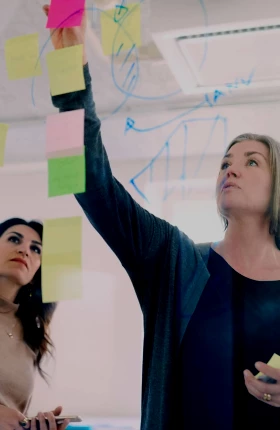Done right, digital marketing leads to a trifecta of benefits: deeper customer relationships, increased sales, and lower costs. But the transition to digital is tough. Marketers struggle with such new approaches, channels, and ways of working as customer journeys, e-commerce, mobile engagement, data analytics, and personalization, not least because technical capabilities have become as important as creative acumen.
Many marketers look to digital innovators for solutions and models. One of these is agile, a way of working from which marketers (and entire companies) can achieve multiple benefits:
- Greater speed and efficiency, fewer errors, and better customer responsiveness
- A data-enabled view of the customer that informs all decisions
- Better alignment—and measurement—of business goals and marketing outcomes
- “Test and learn” agendas that drive consistent incremental improvement
- Reduced complexity caused by technology, inefficient processes, and “siloed” execution
A methodology born in software development, agile is essentially about developing solutions incrementally by iterating quickly (in “sprints”) to adapt to rapidly changing conditions. Agile works by breaking projects down into manageable pieces, prioritizing them, and coming up with solutions in cross-functional teams. When agile practices are implemented successfully, we have seen a 60% reduction in time to market, three- to fourfold increases in the number of conversions, 10% to 30% reductions in marketing costs, and 50% jumps in employee satisfaction. (For more on how agile works, see “ Organizing for Agility in Consumer Companies , BCG article, September 2017; and “ Taking Agile Way Beyond Software ,” BCG article, July 2017.)
But for established organizations, making the transition to operating in agile teams at scale is hard—really hard. In a recent BCG survey, almost nine out of ten marketing executives said that they consider agility very important. But only one in five believe that their companies are agile enough in their ways of working.
In our experience, the firms that successfully implement agile do so as a form of transformation—cultural as well as organizational. They recognize from the start that the changes they will be making are high impact—to both the company and its employees—and that they require clear and flexible planning, focused execution, flexibility, the right HR support, and strong communication and reinforcement. A successful approach follows a well-prepared game plan in each of five areas: setting objectives, engaging other functions, integrating agencies, embedding new cultures and behaviors, and upgrading technology and access to data. Here’s how the companies behind the success stories do it.
Setting the Right Objectives
Agile is all about demonstrating progress and achieving results quickly. At the individual level, members of cross-functional agile teams need to be able to see the big picture. An essential first step is setting goals that measure value to the customer and that are tied to business outcomes, while making sure that everyone on the team is clear about what his or her goals are.
At the team level, agile sprints need goals that move the needle in measureable ways. These objectives can be quite specific, such as improved customer adoption and conversion rates or a shortened time from campaign concept development to launch. The links should be clear between the goals of the team and the marketing function, and might include increasing campaign reach and effectiveness while maintaining or reducing the level of spending. The links between the marketing function and corporate goals should be equally explicit. The latter could include moving from a product-focused strategy to one based on customer journeys or developing the ability to offer personalized service and build customer relationships at scale.
One large automotive OEM gave a new digital team the goal of spending fewer marketing dollars while maintaining top-line performance. The team agreed on the digital metrics that constituted the best indicators of sales and began a rapid rollout of more than 30 pilots developed on the basis of hypotheses from internal and agency stakeholders. The pilots included opportunities to become more efficient and spend less, as well as opportunities to optimize and expand high-ROI activities. The focus on business outcomes drove the team to broaden its scope as the initial pilots identified new adjacent areas of opportunity to explore.
At a global consumer products company, a strong CEO-led focus on marketing ROI led to the adoption of consistent measurement capabilities for the data-driven reallocation of spending across channels and ongoing campaign pilots to improve performance.
Since teams are cross-functional, some members may be working with unfamiliar KPIs. Technology tools such as shared scorecards or dashboards that show key objectives, metrics, and progress can help make these links clear and keep team members focused on their goals and those of other teams working on related issues. (See “ Making Sense of the Marketing Measurement Mess ,” BCG article, February 2017.)
Engaging Other Functions Early
Any system works only as fast as its slowest part. Fast-moving marketers can find themselves—and their campaigns—held back by the (often nonagile) functions on which marketing depends, such as finance, legal, and compliance. It’s also a problem if marketers are working in one agile system and other functions, such as IT, are using another. In an ideal world, marketers build cross-functional teams and work together with other functions to plan and execute campaigns, supported by better technology that speeds creative and content development, review, and approvals. For one airline, involving finance and revenue management as part of agile marketing campaigns was critical to achieving buy-in on results as well as moving quickly to capitalize on findings.
Since companies often have separate teams working on brand, performance, and site or CRM marketing, we have also found that agile teams often need to cross silos to gain a comprehensive view of the customer and her or his needs.
For many companies, though, this is the very definition of culture change, and it’s hard for the marketing function alone to make it happen. If marketers are leading the agile transformation, they need to find ways to bring others along, pushing hard to include people and skills from outside of marketing. And they’ll need help putting in place the enablers, such as new KPIs, incentives, and career paths, that team members require in order to make the transition to new ways of working.
Marketers can work with legal, risk, and compliance to achieve buy-in on the objectives of greater speed and agility and agreement on predefined guidelines and routines that facilitate approvals. One approach is to set guidelines for campaigns and programs within which teams can operate freely (when modifying existing creative content, for example), but beyond which they must seek explicit approval (such as when developing an entirely new campaign).
At Starbucks, a “sandbox” approach to approvals was essential to allowing new techniques, such as dynamic creative development and machine-optimized offer selection, to flourish. Another possible approach is inviting other functions to participate in planning agile sprints and discussing outcomes, even as observers.
Companies develop models suited to their individual needs. At a global pharmaceutical company, for example, agile marketing teams include the relevant control functions (such as medical, regulatory, and legal), and they organize their sprints around the time necessary for review cycles by team members. At a large tech company, each agile marketing team produces a report on Friday morning detailing its outcomes and pinpointing roadblocks; functional managers are asked to resolve any remaining issues by Monday. In many fully agile organizations, control function incentives and performance management programs are even tied to the performance and outcomes of agile teams.
Integrating Agencies
Two principles of agile—working in fast, iterative sprints and using a test-and-learn approach that relies on tight customer feedback loops—upend the traditional campaign development process. Smart agile marketers involve their external agencies in agile initiatives from the planning stage. They include agency personnel in agile training and engage account, creative, and media staff in agile methods. And they give agencies incentives to iterate more quickly and provide real-time measurement data.
Together, advertiser and agency revamp the creative development process. They use online collaboration tools and boards. They test, learn, and adjust, employing feedback loops, facilitating collaboration and transparency, and assessing the performance of both internal and external groups with the same metrics. A consumer products company introduced a new analytical team to manage and measure the performance of agency and internal digital teams.
Agile sometimes forces a tradeoff between pursuing speed and flexibility and perfecting creative content and brand messaging. Companies need to be clear internally and with their agencies about their agile priorities, in terms of both the specific outcomes they are trying to achieve and the overall drive for a more agile way of working. One automaker has established a marketing hub of about 150 people, including staff from four agency partners, colocated in the same building alongside its marketing and media functions. This approach puts all the expert disciplines (creative, content, operational, and social media, among others) in one place. The company has developed standardized ways for its agencies and marketing team to collaborate on campaign development, including performance reviews against predefined shared marketing objectives, as well as budget, quality, and timeliness criteria. Among the benefits are increased agility with better capacity planning and speed to output.
Embedding Agile Culture and Behaviors
The transition to agile is difficult for most marketers. For one thing, it requires a different collective mindset—one that focuses on continual improvement, on getting better every day. For another, it means working on campaigns differently—breaking the work down into iterative components, which is very different from the way most companies and agencies have executed campaigns in the past. In addition, agile marks a fundamental change in approach, since it puts the customer rather than the brand or product front and center.
The key question that agile marketers contend with every day is not how to position a brand in its category or market but how the brand can engage the consumer at multiple points during the purchase journey. Creative instincts—“This campaign is going to be awesome!”—take a back seat to actual data on how consumers respond to online and offline outreach and interactions.
The reliance on data and technology, as well as on testing, learning, and making continual quick adjustments, is another big shift for most marketing organizations. Individuals need to learn to reset their job focus and work collaboratively with people whose skill sets may be very different from their own. Organizations need to develop new training programs, compensation schemes, incentives, and career paths. There will be new KPIs related to speed and learning. One company tracked and reported the number of tests and the speed of campaign execution as new metrics. The marketing function can lead this effort, but it will need active engagement and assistance from top management and from functions such as IT and HR.
Upgrading Technology and Access to Data
Agile digital marketers execute campaigns quickly—they get microsites up in hours rather than weeks, they make changes to campaign management tools in hours rather than days, and they share data seamlessly and securely across functions. Most legacy technology systems are not up to these tasks.
Moreover, because they put the customer front and center, agile approaches depend on continuous access to customer data, both in designing the initial outreach or offer and in adjusting the engagement and maintaining interaction over time. Digital natives have built their business models around collecting data and responding to customer needs.
Leading e-commerce players such as Amazon and Alibaba use customer data to continually tailor interactions, recommendations, and offers and create powerful feedback loops. Starbucks, a leader in personalization, uses data from interactive games that it sends to its loyalty program members as one way of individualizing its brand, providing a customized experience that encompasses in-store visits, digital interactions, and even, potentially, products offered. (See “ Profiting from Personalization ,” BCG article, May 2017.)
Many advertisers are moving to gain greater ownership over advertising platform data by requiring detailed access to data that previously had been left with their agencies.
But executing quickly and providing agile marketers with the kind of data access and processing capabilities that they need require investment in technology and talent. Recent BCG research into the personalization initiatives of major marketers found that companies face a number of technical barriers, including poor data centralization (companies collect ample data but struggle to aggregate it into a universal customer profile), legacy technology that doesn’t support one-to-one communication at scale, and insufficient measurement capabilities. Almost 60% of companies struggle to effectively measure and attribute the impact of campaigns, limiting their ability to learn from customer feedback and adapt accordingly—which are the essence of agile marketing and an individualized brand experience. As one executive told BCG, “We were trying to run agile processes but with none of the data tools that we needed. So it became opinion driven rather than data driven, leading to a high-[customer]-churn environment.”
Start Big, Start Small…but Start Now
For some marketing functions, the transition to agile takes place in the context of a company-wide digital transformation. Many others take on the task themselves, and some companies end up driving a broader transformation with the results that marketing achieves.
Even the benefits of applying agile to select initiatives can be significant, and we have found that adopting agile in this way can be a good starting point, especially for marketing functions that want to move toward agile ways of working while the rest of the company still operates along traditional lines. They can demonstrate success with one or more pilots before embarking on a broader transformation of marketing as a whole.
As digital technologies play a bigger role in all aspects of marketing, and as establishing direct relationships with consumers becomes more important, every marketing organization will have to operate differently. Agile ways of working will become far more common, if not the norm, because like digital, they put the customer at the center of the endeavor. In the very near future, agile will be an essential enabling capability. That’s why marketing organizations should start their transformations, or at least their experiments, now.










